The History Of Maybach

Maybach-Motorenbau GmbH (IPA:[ˈmaɪ.bax]) (founded 1909) is a German luxury car manufacturer. It was founded in 1909 by Wilhelm Maybach with his son Karl Maybach as director. The company was originally a subsidiary of Luftschiffbau Zeppelin GmbH and was itself known as "Luftfahrzeug-Motoreinbau GmbH" (literally "Airship Engine Company") until 1918. Today, the brand is owned by Daimler AG and based in Stuttgart.
Maybach has historic roots through the involvement of Wilhelm Maybach, who was the technical director of the Daimler-Motoren-Gesellschaft. The company originally developed and manufactured diesel and gas engines for Zeppelins, and then rail cars.
The company first built an experimental car in 1919, with the first production model introduced two years later at the Berlin Motor Show. Between 1921 and 1940, the company produced various classic opulent vehicles. The company also continued to build heavy duty diesel engines for marine and rail purposes.
Maybach contributed to the German war effort in World War II by producing the engines for the formidable Panther and Tiger tanks such as the Maybach HL230. After the war the factory performed some repair work, but automotive production was never restarted, and some 20 years later, the company was renamed into MTU Friedrichshafen.
In 1997, Mercedes-Benz presented at the Tokyo Motorshow a luxury concept car under the name Mercedes-Benz Maybach (V12, 5987 cc, 550 hp). Mercedes-Benz decided to develop it; however, Mercedes made the decision to market the car under the sole brand name of Maybach.
Maybach was therefore revived as a brand in the early 2000s, with the production of the new model in two sizes — the Maybach 57 and the Maybach 62. The numbers are equal to the lengths of the automobiles in decimetres. In 2005, the new 57S was added, sporting a 6.0L V12 bi-turbo engine, producing 604bhp (450kW) and 737lb·ft (999N·m) of torque, and featuring various cosmetic touches.
The company offers various options for customers to personalise their vehicles, and provides various equipment combinations.
Pre-war
- 1919 Maybach W1: Test car based on a Mercedes chassis
- 1921 Maybach W3: First Maybach, shown at Berlin Motor Show. Featured a 70hp (52kW) 5.7L inline six.
- 1926 Maybach W5: 7L inline six, 120hp (89kW)
- 1929 Maybach 12: V12 precursor to DS7/ 8
- 1930 Maybach DSH: Doppel-Sechs-Halbe ("half a twelve cylinder") 1930-37
- 1930 Maybach DS7 Zeppelin: 7L V12, 150hp (112kW)
- 1931 Maybach W6: Same engine as W5, longer wheelbase. 1931-33
- 1931 Maybach DS8 Zeppelin: 8L V12, 200hp (150kW)
- 1934 Maybach W6 DSG: Featuring a twin overdrive transmission system.
- 1935 Maybach SW35: 3.5L 140hp (104kW) I6
- 1936 Maybach SW38: 3.8L 140hp (104kW) I6
- 1939 Maybach SW42: 4.2L 140hp (104kW) I6
- 1945 Maybach JW61: 3.8L 145hp (108kW) I6
W2 were the 5.7L inline six engines built for and ordered by Spyker. Not all were purchased, and Karl had to build cars featuring the engines to offset costs.
Around 1800 Maybachs were built before WW2.
Post-revival
- 2002 Maybach 57 and 62
- 2005 Maybach Exelero (prototype shown at the IAA in Frankfurt)
- 2005 Maybach 57S (the S standing for Special rather than Sport)
- 2006 Maybach 62S
- 2007 Maybach 62 Landaulet
The Maybach 57 has a 0 to 60 acceleration of about 5.4 seconds. The Maybach 62 and 57 S both have a 0 to 60 acceleration of about 5.2 seconds. The Maybach 62 S gets to 60mph in 4.7 seconds. The Landaulet gets to 60mph in 4.5. These acceleration times aren't terribly unusual these days, especially for the 57, but impressive considering that these cars weigh well over 6,000 pounds. Maybachs in general are extremely powerful, with all models producing (well) over 500bhp. The Maybach 57 has 518bhp, the Maybach 57 S has 559bhp, the Maybach 62 has 570bhp, the Maybach 62 S has 612bhp, and the Landaulet has 633bhp. Maybachs are also very luxurious. Standard luxury features of all Maybachs include, and are limited to, a voice-activated navigation system, remote start, heated and cooled front and rear seats, rear curtain, front and back seat massage, voice-activated AM/ FM radio with 10-disc CD/ DVD changer, premium 24-speaker sound system, rear DVD entertainment system, sunroof (with button to control) air conditioning with tri-zone automatic climate controls, a heated and cooled leather wrapped steering wheel with radio and climate controls, keyless entry, wireless connection, heated and cooled cupholders, rearview camera, adaptive cruise control, voice-activated power front and rear seats, trip computer, tachometer, iPod/ MP3 holder/ charger, and night vision. However, the Maybach 62, 62 S, and Landaulet have standard features that the 57 does not have. These include footrests, voice-activated sunroof (rather than a button-activated sunroof), 2nd-row tables, and heated windows. The base price of a 2009 Maybach 57 is $344,000, the base price of a Maybach 57 S is $381,000, the base price of a Maybach 62 is $394,000, the Maybach 62 S is $430,000, and the Maybach Landaulet semi convertible is just under $470,000. A used 30,000-mile 2004 Maybach 57 can probably be purchased for around $200,000.
Future models
Three new models are expected, a 4-seat sedan derived from the Mercedes-Benz CLS-Class, a full-size luxury SUV derived from the GL-Class, and a smaller sedan, which would be sold for $250,000. Recently, they announced that they will launch a Landaulet convertible like the Maybachs of old and this will be first shown in Dubai
Initially, Daimler-Crysler predicted annual sales of 1,000 global units with 50% coming from the United States. However such lofty sales expectations never materialized. In 2007 Mercedes did a buy back of 29 US dealers reducing the total number from 71 to 42.
Cite error: <ref> tags exist, but no <references/ > tag was found
From Wikipedia, the free encyclopedia
More About Maybach
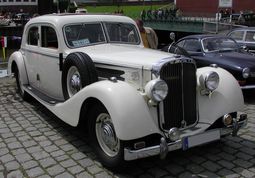
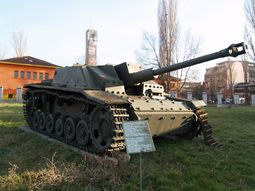
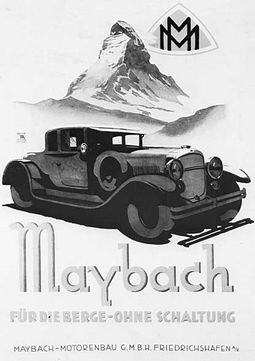
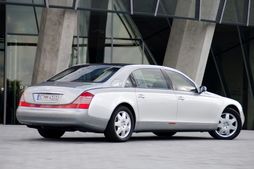
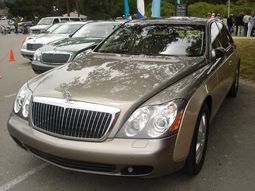
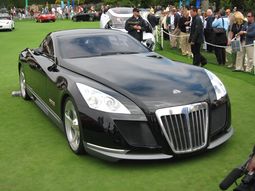
|